

Compact Muon Solenoid
LHC, CERN
| CMS-PAS-SUS-15-009 | ||
| Search for natural supersymmetry in events with top quark pairs and photons in pp collisions at √s= 8 TeV | ||
| CMS Collaboration | ||
| October 2016 | ||
| Abstract: We present a search for a natural gauge-mediated supersymmetry breaking scenario with the top squark as the lightest squark and the gravitino as the lightest supersymmetric particle. The strong production of top squark pairs and their decays would produce events with pairs of top quarks and neutralinos, with each neutralino decaying to a photon and a gravitino. This search is performed with the CMS experiment using pp collision data at √s= 8 TeV, corresponding to an integrated luminosity of 19.7 fb−1, in the electron + jets and muon + jets channel, requiring one or two photons in the final state. We compare the missing transverse momentum of these events against the expected spectrum of standard model processes. No excess of events is observed beyond background predictions and the result of the search is interpreted in the context of a general model of gauge-mediated supersymmetry breaking deriving limits on the mass of top squarks up to 750 GeV. | ||
|
Links:
CDS record (PDF) ;
inSPIRE record ;
CADI line (restricted) ;
These preliminary results are superseded in this paper, JHEP 03 (2018) 167. The superseded preliminary plots can be found here. |
||
| Figures | |
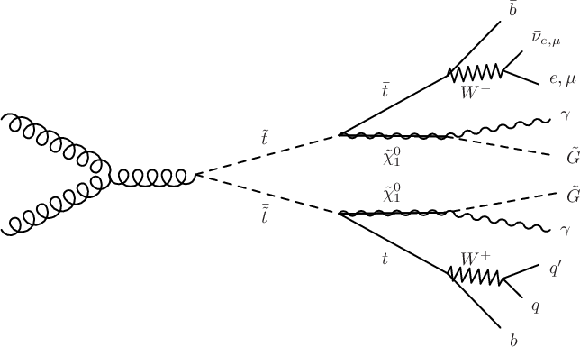
png pdf |
Figure 1:
Feynman diagram of the GMSB scenario of interest. With top squarks as the lightest squark, the pair production of stops would be the dominant production mechanism for SUSY in pp collisions at the LHC. Assuming a bino-like neutralino NLSP, each stop would decay to a top quark and a neutralino, with the neutralino decaying to a photon and gravitino. Shown above is the electron+jets or muon+jets final state of the top pair decay. |

png pdf |
Figure 2:
Template fit results for the dilepton invariant mass in deriving SFZ(γ) for the electron (left) and muon (middle) channels. The template fit result for SFe→γ in meγ for the electron channel in SR1 with the b tag requirement removed is shown on the right. The ratio of data to the total background is included at the bottom of each figure. Uncertainties shown are statistical only. |
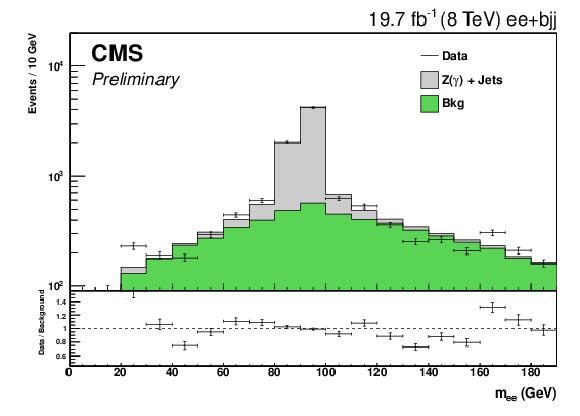
png pdf |
Figure 2-a:
Template fit results for the dilepton invariant mass in deriving SFZ(γ) for the electron channel. The ratio of data to the total background is included at the bottom of the figure. Uncertainties shown are statistical only. |

png pdf |
Figure 2-b:
Template fit results for the dilepton invariant mass in deriving SFZ(γ) for the muon channel. The ratio of data to the total background is included at the bottom of the figure. Uncertainties shown are statistical only. |

png pdf |
Figure 2-c:
The template fit result for SFe→γ in meγ for the electron channel in SR1 with the b tag requirement removed is shown. The ratio of data to the total background is included at the bottom of the figure. Uncertainties shown are statistical only. |
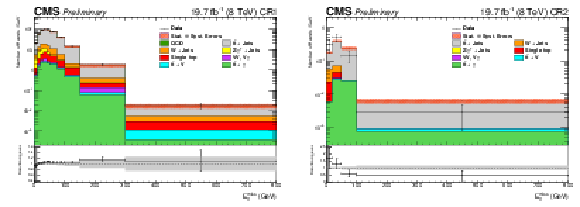
png pdf |
Figure 3:
Comparison of data and MC in EmissT for the combined (e+μ) control regions. Both CR1 (left) with one misidentified photon and CR2 (right) with two misidentified photons are shown. The disagreement of 10-20% between data and MC in CR1 is taken as an additional shape-based systematic uncertainty in the signal regions. The comparitively poor agreement in CR2 is attributable to the very small number of events in data and is not taken as an additional uncertainty. |
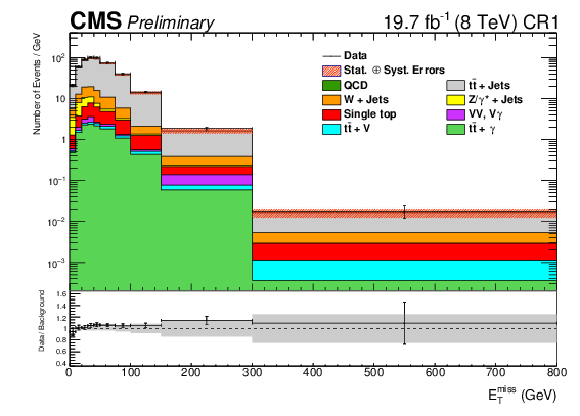
png pdf |
Figure 3-a:
Comparison of data and MC in EmissT for the combined (e+μ) control region CR1, with one misidentified photon. The disagreement of 10-20% between data and MC in CR1 is taken as an additional shape-based systematic uncertainty in the signal regions. |

png pdf |
Figure 3-b:
Comparison of data and MC in EmissT for the combined (e+μ) control region CR2, with two misidentified photons. The comparitively poor agreement in CR2 is attributable to the very small number of events in data and is not taken as an additional uncertainty. |

png pdf |
Figure 4:
Comparison of data and MC in EmissT for the combined (e+μ) signal regions. SR1 (left) with one reconstructed photon and SR2 (right) with two reconstructed photons are shown. |
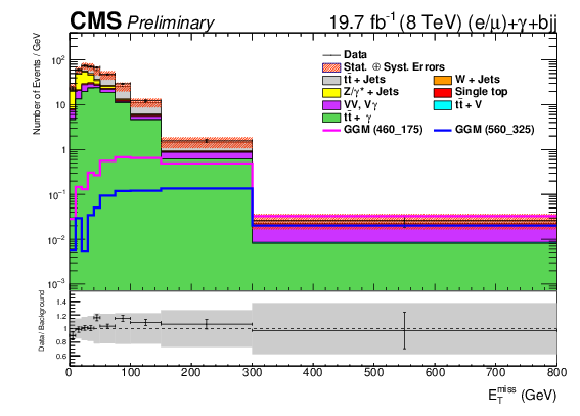
png pdf |
Figure 4-a:
Comparison of data and MC in EmissT for the combined (e+μ) signal region SR1, with one reconstructed photon. |

png pdf |
Figure 4-b:
Comparison of data and MC in EmissT for the combined (e+μ) signal region SR2, with two reconstructed photons. |

png pdf |
Figure 5:
Observed upper cross section CLs limits at 95% CL in the MStop - MBino plane. |
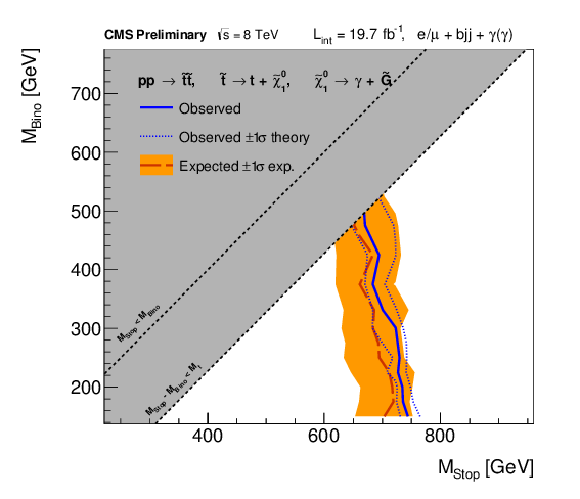
png pdf |
Figure 6:
Observed and expected 95% CL exclusion contours for stop and bino masses. |
| Tables | |

png pdf |
Table 1:
Scale factors for the normalization of Z(γ)+jets backgrounds and electron-to-photon misidentification rate. For the electron+jets channel, the product of the two is applied to Z+jets and W/Z+γ backgrounds. For the muon+jets channel, only the first one is applied. The uncertainties displayed are statistical followed by all systematic uncertainties added in quadrature. |
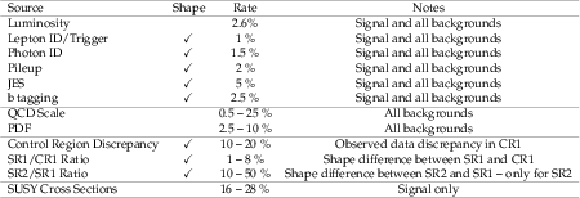
png pdf |
Table 2:
Summary of systematic uncertainties considered. The dominant rate uncertainty is the tˉt+γ and Vγ normalizations, although the tˉt+jets and tˉt+γ backgrounds are allowed to float freely in the upper limit determination. Check marks indicate uncertainties that affect the shape of the EmissT distribution in addition to overall rates. The dominant shape uncertainties are the control region-derived uncertainties. |

png pdf |
Table 3:
Observed data and expected background yields for the combined (e+μ) signal regions. Expectations from two GMSB signal models are included, for which (460-175) refers to Mstop=460 GeV and Mbino=175 GeV and similarly for (560-325). The errors represented below are statistical followed by all systematic uncertainties added in quadrature. |
| Summary |
| We have presented a search for natural gauge-mediated supersymmetry breaking in events with a top quark pair and photons. No significant excess in the shape of the EmissT distribution is observed that would indicate the presence of new physics. Cross section upper limits are calculated for a range of stop and bino masses, and stop masses below 650-750 GeV (depending on the bino mass) are excluded. These results set the most stringest exclusion on stop masses in GMSB scenarios available to date. |
| References | ||||
| 1 | J. Wess and B. Zumino | Supergauge transformations in four-dimensions | Nucl. Phys. B 70 (1974) 39 | |
| 2 | \relax Yu. A. Golfand and E. P. Likhtman | Extension of the Algebra of Poincare Group Generators and Violation of p Invariance | JEPTL 13 (1971) 323--326.[Pisma Zh. Eksp. Teor. Fiz.13,452(1971)] | |
| 3 | D. V. Volkov and V. P. Akulov | Possible universal neutrino interaction | JEPTL 16 (1972) 438--440, .[Pisma Zh. Eksp. Teor. Fiz.16,621(1972)] | |
| 4 | A. H. Chamseddine, R. L. Arnowitt, and P. Nath | Locally supersymmetric grand unification | PRL 49 (1982) 970 | |
| 5 | G. L. Kane, C. F. Kolda, L. Roszkowski, and J. D. Wells | Study of constrained minimal supersymmetry | PRD 49 (1994) 6173 | hep-ph/9312272 |
| 6 | P. Fayet | Supergauge invariant extension of the Higgs mechanism and a model for the electron and its neutrino | Nucl. Phys. B 90 (1975) 104 | |
| 7 | R. Barbieri, S. Ferrara, and C. A. Savoy | Gauge models with spontaneously broken local supersymmetry | PLB 119 (1982) 343 | |
| 8 | L. J. Hall, J. D. Lykken, and S. Weinberg | Supergravity as the messenger of supersymmetry breaking | PRD 27 (1983) 2359 | |
| 9 | P. Ramond | Dual theory for free fermions | PRD 3 (1971) 2415 | |
| 10 | CMS Collaboration Collaboration | Observation of a new boson at a mass of 125 GeV with the CMS experiment at the LHC | PLB 716 (2012) 30--61 | 1207.7235 |
| 11 | ATLAS Collaboration | Observation of a new particle in the search for the Standard Model Higgs boson with the ATLAS detector at the LHC | PLB 716 (2012) 1--29 | 1207.7214 |
| 12 | CMS Collaboration | Precise determination of the mass of the Higgs boson and tests of compatibility of its couplings with the standard model predictions using proton collisions at 7 and 8 TeV | EPJC 75 (2015), no. 5, 212 | CMS-HIG-14-009 1412.8662 |
| 13 | ATLAS Collaboration | Measurements of the Higgs boson production and decay rates and coupling strengths using pp collision data at √s= 7 and 8 TeV in the ATLAS experiment | EPJC76 (2016), no. 1, 6 | 1507.04548 |
| 14 | ATLAS, CMS Collaboration | Combined Measurement of the Higgs Boson Mass in pp Collisions at √s= 7 and 8 TeV with the ATLAS and CMS Experiments | PRL 114 (2015) 191803 | 1503.07589 |
| 15 | J. Barnard, B. Farmer, T. Ghergetta, and M. White | Natural gauge mediation with a bino NLSP at the LHC | PRL 109 (2012) 241801 | 1208.6062 |
| 16 | Y. Kats, P. Meade, M. Reece, and D. Shih | The Status of GMSB After 1/fb at the LHC | JHEP 02 (2012) 115 | 1110.6444 |
| 17 | R. Barbieri and A. Strumia | The 'LEP paradox' | in 4th Rencontres du Vietnam: Physics at Extreme Energies (Particle Physics and Astrophysics) Hanoi, Vietnam, July 19-25, 2000 2000 | hep-ph/0007265 |
| 18 | P. Fayet | Mixing Between Gravitational and Weak Interactions Through the Massive Gravitino | PLB 70 (1977) 461 | |
| 19 | P. Fayet | Scattering Cross-Sections of the Photino and the Goldstino (Gravitino) on Matter | PLB 86 (1979) 272 | |
| 20 | P. Fayet | Lower Limit on the Mass of a Light Gravitino from e+ e- Annihilation Experiments | PLB 175 (1986) 471 | |
| 21 | P. Meade, N. Seiberg, and D. Shih | General Gauge Mediation | Prog. Theor. Phys. Suppl. 177 (2009) 143--158 | 0801.3278 |
| 22 | M. Buican, P. Meade, N. Seiberg, and D. Shih | Exploring General Gauge Mediation | JHEP 03 (2009) 016 | 0812.3668 |
| 23 | S. Abel, M. J. Dolan, J. Jaeckel, and V. V. Khoze | Phenomenology of Pure General Gauge Mediation | JHEP 12 (2009) 001 | 0910.2674 |
| 24 | R. Barbier et al. | R-parity violating supersymmetry | PR 420 (2005) 1 | hep-ph/0406039 |
| 25 | G. R. Farrar and P. Fayet | Phenomenology of the production, decay, and detection of new hadronic states associated with supersymmetry | PLB 76 (1978) 575 | |
| 26 | P. Meade, N. Seiberg, and D. Shih | General gauge mediation | Prog. Theor. Phys. Suppl. 177 (2009) 143 | |
| 27 | M. Buican, P. Meade, N. Seiberg, and D. Shih | Exploring general gauge mediation | JHEP 03 (2009) 016 | |
| 28 | J. T. Ruderman and D. Shih | General neutralino NLSPs at the early LHC | JHEP 08 (2012) 159 | 1103.6083 |
| 29 | Y. Kats, P. Meade, M. Reece, and D. Shih | The status of GMSB after 1/fb at the LHC | JHEP 02 (2012) 115 | 1110.6444 |
| 30 | Y. Kats and M. J. Strassler | Probing colored particles with photons, leptons, and jets | JHEP 11 (2012) 097 | 1204.1119 |
| 31 | P. Grajek, A. Mariotti, and D. Redigolo | Phenomenology of general gauge mediation in light of a 125 GeV Higgs | JHEP 07 (2013) 109 | 1303.0870 |
| 32 | CMS Collaboration | Performance of Photon Reconstruction and Identification with the CMS Detector in Proton-Proton Collisions at √s= 8 TeV | JINST 10 (2015), no. 08, P08010 | CMS-EGM-14-001 1502.02702 |
| 33 | CMS Collaboration | The CMS experiment at the CERN LHC | JINST 3 (2008) S08004 | CMS-00-001 |
| 34 | CMS Collaboration Collaboration | Particle-Flow Event Reconstruction in CMS and Performance for Jets, Taus, and MET | Technical Report CMS-PAS-PFT-09-001, CERN, 2009. Geneva, Apr | |
| 35 | CMS Collaboration Collaboration | Commissioning of the Particle-flow Event Reconstruction with the first LHC collisions recorded in the CMS detector | Technical Report CMS-PAS-PFT-10-001, CERN, 2010 | |
| 36 | CMS Collaboration Collaboration | Commissioning of the Particle-Flow reconstruction in Minimum-Bias and Jet Events from pp Collisions at 7 TeV | Technical Report CMS-PAS-PFT-10-002, CERN, Geneva | |
| 37 | M. Cacciari, G. P. Salam, and G. Soyez | The anti-kT jet clustering algorithm | JHEP 04 (2008) 063 | 0802.1189 |
| 38 | M. Cacciari, G. P. Salam, and G. Soyez | FastJet user manual | EPJC 72 (2012) 1896 | 1111.6097 |
| 39 | CMS Collaboration | Performance of CMS muon reconstruction in pp collision events at √s= 7 TeV | JINST 7 (2012) P10002 | CMS-MUO-10-004 1206.4071 |
| 40 | S. Baffioni et al. | Electron reconstruction in CMS | EPJC 49 (2007), no. 4, 1099--1116 | |
| 41 | CMS Collaboration Collaboration | Algorithms for b Jet identification in CMS | Technical Report CMS-PAS-BTV-09-001, CERN, 2009. Geneva, Jul | |
| 42 | J. Alwall et al. | MadGraph 5: going beyond | JHEP 06 (2011) 128 | 1106.0522 |
| 43 | T. Sjostrand, S. Mrenna, and P. Z. Skands | PYTHIA 6.4 physics and manual | JHEP 05 (2006) 026 | hep-ph/0603175 |
| 44 | S. Frixione, P. Nason, and C. Oleari | Matching NLO QCD computations with Parton Shower simulations: the POWHEG method | JHEP 0711 (2007) 070 | 0709.2092 |
| 45 | Z. Was | TAUOLA the library for tau lepton decay, and KKMC / KORALB / KORALZ /... status report | Nucl.Phys.Proc.Suppl. 98 (2001) 96--102 | hep-ph/0011305 |
| 46 | R. Field | Min-Bias and the Underlying Event at the LHC | Acta Phys.Polon. B 42 (2011) 2631--2656 | 1110.5530 |
| 47 | A. Djouadi, J.-L. Kneur, and G. Moultaka | SuSpect: A Fortran code for the supersymmetric and Higgs particle spectrum in the MSSM | Comput.Phys.Commun. 176 (2007) 426--455 | hep-ph/0211331 |
| 48 | M. Muhlleitner, A. Djouadi, and Y. Mambrini | SDECAY: a Fortran code for the decays of the supersymmetric particles in the MSSM | Computer Physics Communications 168 (2005), no. 1, 46 -- 70 | |
| 49 | W. Beenakker, R. Hopker, and M. Spira | PROSPINO: A Program for the production of supersymmetric particles in next-to-leading order QCD | hep-ph/9611232 | |

|
Compact Muon Solenoid LHC, CERN |

|

|

|

|

|

|